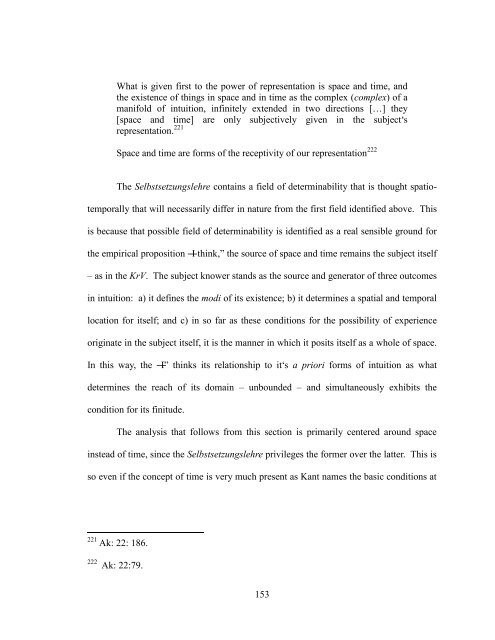The Doctrine of Self-positing and Receptivity in Kant's Late ...
The Doctrine of Self-positing and Receptivity in Kant's Late ...
The Doctrine of Self-positing and Receptivity in Kant's Late ...
Create successful ePaper yourself
Turn your PDF publications into a flip-book with our unique Google optimized e-Paper software.
What is given first to the power <strong>of</strong> representation is space <strong>and</strong> time, <strong>and</strong><br />
the existence <strong>of</strong> th<strong>in</strong>gs <strong>in</strong> space <strong>and</strong> <strong>in</strong> time as the complex (complex) <strong>of</strong> a<br />
manifold <strong>of</strong> <strong>in</strong>tuition, <strong>in</strong>f<strong>in</strong>itely extended <strong>in</strong> two directions […] they<br />
[space <strong>and</strong> time] are only subjectively given <strong>in</strong> the subject‘s<br />
representation. 221<br />
Space <strong>and</strong> time are forms <strong>of</strong> the receptivity <strong>of</strong> our representation 222<br />
<strong>The</strong> Selbstsetzungslehre conta<strong>in</strong>s a field <strong>of</strong> determ<strong>in</strong>ability that is thought spatio-<br />
temporally that will necessarily differ <strong>in</strong> nature from the first field identified above. This<br />
is because that possible field <strong>of</strong> determ<strong>in</strong>ability is identified as a real sensible ground for<br />
the empirical proposition ―I th<strong>in</strong>k,‖ the source <strong>of</strong> space <strong>and</strong> time rema<strong>in</strong>s the subject itself<br />
– as <strong>in</strong> the KrV. <strong>The</strong> subject knower st<strong>and</strong>s as the source <strong>and</strong> generator <strong>of</strong> three outcomes<br />
<strong>in</strong> <strong>in</strong>tuition: a) it def<strong>in</strong>es the modi <strong>of</strong> its existence; b) it determ<strong>in</strong>es a spatial <strong>and</strong> temporal<br />
location for itself; <strong>and</strong> c) <strong>in</strong> so far as these conditions for the possibility <strong>of</strong> experience<br />
orig<strong>in</strong>ate <strong>in</strong> the subject itself, it is the manner <strong>in</strong> which it posits itself as a whole <strong>of</strong> space.<br />
In this way, the ―I‖ th<strong>in</strong>ks its relationship to it‘s a priori forms <strong>of</strong> <strong>in</strong>tuition as what<br />
determ<strong>in</strong>es the reach <strong>of</strong> its doma<strong>in</strong> – unbounded – <strong>and</strong> simultaneously exhibits the<br />
condition for its f<strong>in</strong>itude.<br />
<strong>The</strong> analysis that follows from this section is primarily centered around space<br />
<strong>in</strong>stead <strong>of</strong> time, s<strong>in</strong>ce the Selbstsetzungslehre privileges the former over the latter. This is<br />
so even if the concept <strong>of</strong> time is very much present as Kant names the basic conditions at<br />
221 Ak: 22: 186.<br />
222 Ak: 22:79.<br />
153


